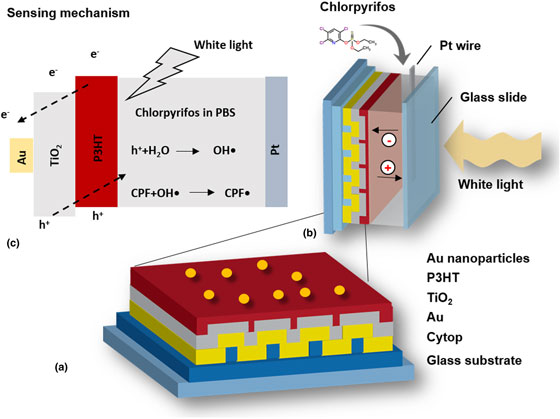Crossref Citations
This article has been cited by the following publications. This list is generated based on data provided by
Crossref.
Khezripour, Zahra
Fouladi Mahani, Fatemeh
and
Mokhtari, Arash
2018.
Double-sided TiO2nano-gratings for broadband performance enhancement of organic solar cells.
Journal of the Optical Society of America B,
Vol. 35,
Issue. 10,
p.
2478.
Li, Qian
Dou, Xiaowen
Zhang, Lei
Zhao, Xiangsheng
Luo, Jiaoyang
and
Yang, Meihua
2019.
Oriented assembly of surface plasmon resonance biosensor through staphylococcal protein A for the chlorpyrifos detection.
Analytical and Bioanalytical Chemistry,
Vol. 411,
Issue. 23,
p.
6057.
Weerathunge, Pabudi
Behera, Bijay Kumar
Zihara, Sabna
Singh, Mandeep
Prasad, Sanjana Naveen
Hashmi, Sabeen
Mariathomas, Pyria Rose Divina
Bansal, Vipul
and
Ramanathan, Rajesh
2019.
Dynamic interactions between peroxidase-mimic silver NanoZymes and chlorpyrifos-specific aptamers enable highly-specific pesticide sensing in river water.
Analytica Chimica Acta,
Vol. 1083,
Issue. ,
p.
157.
Phetsang, Sopit
Phengdaam, Apichat
Lertvachirapaiboon, Chutiparn
Ishikawa, Ryousuke
Shinbo, Kazunari
Kato, Keizo
Mungkornasawakul, Pitchaya
Ounnunkad, Kontad
and
Baba, Akira
2019.
Investigation of a gold quantum dot/plasmonic gold nanoparticle system for improvement of organic solar cells.
Nanoscale Advances,
Vol. 1,
Issue. 2,
p.
792.
Deng, Yonghui
2019.
Semiconducting Metal Oxides for Gas Sensing.
p.
137.
Howard, Tyler V.
Berry, Keith R.
and
Roper, D. Keith
2021.
Initial dynamic thermal dissipation modes enhance heat dissipation in gold nanoparticle–polydimethylsiloxane thin films.
Journal of Thermal Analysis and Calorimetry,
Vol. 143,
Issue. 6,
p.
3899.
Wang, Haixia
Liang, Dong
Xu, Yan
Liang, Xiang
Qiu, Xiaoqing
and
Lin, Zhang
2021.
A highly efficient photoelectrochemical sensor for detection of chlorpyrifos based on 2D/2D β-Bi2O3/g-C3N4 heterojunctions.
Environmental Science: Nano,
Vol. 8,
Issue. 3,
p.
773.
Soongsong, Jittrapun
Lerdsri, Jamras
and
Jakmunee, Jaroon
2021.
A facile colorimetric aptasensor for low-cost chlorpyrifos detection utilizing gold nanoparticle aggregation induced by polyethyleneimine.
The Analyst,
Vol. 146,
Issue. 15,
p.
4848.
Anuthum, Siriporn
Hasegawa, Fugo
Lertvachirapaiboon, Chutiparn
Shinbo, Kazunari
Kato, Keizo
Ounnunkad, Kontad
and
Baba, Akira
2022.
Plasmonic photothermal properties of silver nanoparticle grating films.
Physical Chemistry Chemical Physics,
Vol. 24,
Issue. 11,
p.
7060.
Dong, Xiuxiu
Liu, Dong
Meng, Xiangle
and
You, Tianyan
2022.
Research progress on photoelectrochemical sensors for contamination analysis in agricultural fields.
Analytical Sciences,
Vol. 38,
Issue. 3,
p.
459.
Mehrdad, Farzad
and
Ahangari, Zahra
2022.
Design and simulation of a gas sensitive junctionless FinFET based on conducting polymer as the gate material.
Physica Scripta,
Vol. 97,
Issue. 7,
p.
075805.
Lazarević-Pašti, Tamara
Tasić, Tamara
Milanković, Vedran
and
Potkonjak, Nebojša
2023.
Molecularly Imprinted Plasmonic-Based Sensors for Environmental Contaminants—Current State and Future Perspectives.
Chemosensors,
Vol. 11,
Issue. 1,
p.
35.
Deng, Yonghui
2023.
Semiconducting Metal Oxides for Gas Sensing.
p.
253.
Jaikeandee, Wisansaya
Nootchanat, Supeera
Lertvachirapaiboon, Chutiparn
Ekgasit, Sanong
Shinbo, Kazunari
Kato, Keizo
and
Baba, Akira
2024.
Polymeric grating prism-based dual-mode miniature surface plasmon resonance sensor chip.
RSC Applied Interfaces,
Vol. 1,
Issue. 6,
p.
1285.
